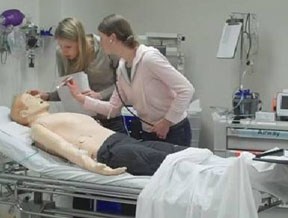 Pharmacology pioneers the use of human patient simulation (HPS) in second year medical education at VCU.
Pharmacology pioneers the use of human patient simulation (HPS) in second year medical education at VCU.
Critical thinking and the ability to function as part of a health professional team are important components in the training of medical students. Led by Edward J.N. Ishac, Ph.D., professor in the Department of Pharmacology and Toxicology, the department is pioneering the use of high-fidelity human patient simulators (HPS) in the second year medical curriculum. He believes that HPS provides a unique opportunity to expand the classroom and mimic the clinical situation in a controlled environment. The students can apply their knowledge in a realistic scenario that can be standardized to encourage active learning without the fear of causing actual patient harm. HPS was first introduced in the Principles of Pharmacology course at the start of the M2 year in 2010.
Recent technology advances have enhanced the quality and capabilities of patient simulators with wireless management and monitoring from a control center. The current state-of-the-art SimMan 3G is a robot that can talk and be programmed to exhibit appropriate physiological responses such as vital signs, convulsions, sweating, bleeding or cardiac arrest. The department goes to great lengths to couple the clinical cases to the course material and objectives. The scenarios are very realistic with mannequin dialogue design, availability of medical equipment, laboratory testing, patient monitoring and access to a standard drug toolbox. Since the students are early in their medical training and have very limited clinical experience we focus on changes in vital signs such as blood pressure, respiration, pupil response, abdominal or chest sounds. At the beginning of the simulation the students are first tested on their ability to accurately measure these parameters. “This allows the students to become comfortable with the technology and the human simulation environment” says Dr. Ishac.
Today we have over 10 case scenarios to challenge students, according to Dr. Sandra Welch, professor of pharmacology and toxicology, who leads the session on pain management. The goal is to allow the students the opportunity for the correct assessment and management of a medical emergency. Simulations range from drug overdose with opiates and crisis events such as anaphylaxis to acute drug toxicity and pesticide poisoning. Students are randomly assigned to one of a number of teams consisting of 5-6 members. Each team is required to take a patient history, make a differential diagnosis, administer appropriate pharmacotherapy and monitor the outcome of their treatment.
An important component of the use of patient simulation is the debriefing session that follows each case scenario, according to Dr. Susan Robinson, professor in pharmacology and toxicology. To maximize active participation and critical thinking the debriefing session is student led but facilitated by a faculty member to ensure that all important points are covered and any residual questions are resolved. The department records each session for playback during the debriefing or for later review. “The students really ‘get it’ when they have to put into practice what they have learned in class” Robinson said.
Given the benefits of the use of human simulation it is not surprising that the student reaction has been overwhelmingly positive with comments such as ‘this was a fantastic experience, I wish we had it earlier in the course because it’s easier to learn these drugs when applying them in person in real time’, ‘excellent experience and I enjoyed the debrief’, ‘I want more simulations, definitely use in other courses’, and ‘add more simulations, strongly, strongly, strongly agree’.
Based on the success of HPS in the pharmacology course and the feedback from students, Drs. Robert Balster, professor of pharmacology and toxicology and Michael Weaver, Associate Professor in the Department of Internal Medicine, have expanded simulation to be included in the behavioral sciences course toward the end of the student’s second year.
As a teaching tool, patient simulation has proven to be a valuable resource that complements in-class traditional methods of instruction.
“It offers a unique opportunity to engage in active learning and introduce clinical integration earlier into the medical curriculum,” Ishac said.
As a teaching tool, patient simulation has proven to be a valuable resource that complements in class traditional methods of instruction. It offers a unique opportunity to engage in active learning and introduce clinical integration earlier into the medical curriculum says Dr. Ishac.